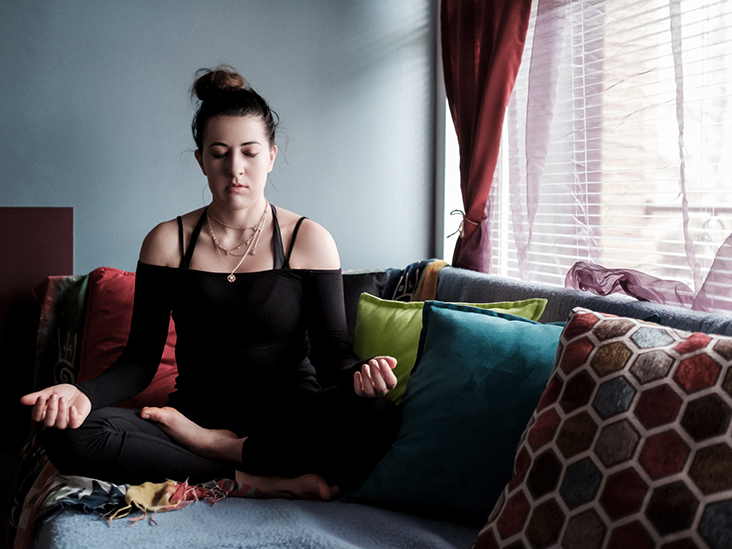Exercises for anxiety relief may help a person manage certain anxiety symptoms, such as muscle tension, increased heart rate, and rapid breathing. Breathing exercises help foster deep, even breaths that promote diaphragmatic breathing. These exercises may reduce anxiety and help a person relax by restoring a typical breathing pattern.
Anxiety disorders are among the most common mental health problems in the United States, affecting about 40 million individuals. Although doctors can successfully treat these conditions, only 4 in 10 people with anxiety seek treatment.
Anxiety can
This article looks at anxiety reduction exercises and how they may help individuals cope.
People can use various relaxation and breathing exercises to help reduce feelings of anxiety.
During an anxiety attack, the body incorrectly thinks it is in danger and
Anxiety exercises can help reduce the symptoms of a panic attack or generalized anxiety. For example, slow breathing techniques can
Individuals can use the following anxiety exercises to reduce feelings of stress, anxiety, and panic.
Alternate nostril breathing, known as Nadi Shodhana, is a yoga breathing technique that
An individual blocks off one nostril while breathing through the other, then switches to exhale through the other nostril.
Perform the breathing exercise in rounds of 10.
People should return to breathing normally if they begin to feel lightheaded.
Pursed lip breathing helps an individual breathe slowly, deeply, and more intentionally. It is a simple breathing technique that helps make deep breaths slower and more intentional.
People living with lung conditions such as emphysema and chronic obstructive pulmonary disease (COPD) use this technique to control shortness of breath and ease anxiety.
Also called coherent breathing, this technique can help reduce anxiety and allow a person to enter a more relaxed state.
Although resonance frequency breathing rate varies among individuals, the typical range is 4.5 to 7 breaths per minute.
Individuals can use this simple breathing exercise while standing, sitting, or lying down. However, people should also consider adding it to their daily routine to get the most benefit.
A
Doctors typically
People living with anxiety disorders may benefit from supportive talks and education about the condition. In addition, doctors may recommend cognitive behavioral therapy (CBT) because numerous studies show that it is an effective treatment option for anxiety disorders. CBT aims to reduce anxiety symptoms by identifying and changing how the individual thinks and behaves.
Doctors often first recommend selective serotonin reuptake inhibitors (SSRIs) and serotonin-norepinephrine reuptake inhibitors (SNRIs). However, individuals must understand that these antidepressant medications may take several weeks to produce positive changes. Additionally, these medications can cause adverse effects, such as increased anxiety symptoms and jitteriness, particularly when a person first starts taking them.
Other medication options include:
Learn more about treatments for anxiety.
Natural herbs and alternate medications may also work for some people. Learn about these therapies.
Although most people feel anxiety and worry from time to time, it is important to talk with a doctor if anxiety is affecting daily life or causing distress.
A person may have generalized anxiety disorder (GAD) if they worry uncontrollably, anxiety significantly affects their job and social life, and they have worried almost daily for at least 6 months.
A doctor can confirm this diagnosis and rule out other conditions that could cause anxiety symptoms, including anemia or an overactive thyroid gland.
Anxiety is a common mental health issue that doctors typically treat using medication and psychotherapy.
Anxiety exercises are another technique that can help an individual manage certain anxiety symptoms, such as rapid breathing, racing heart rate, and tense muscles.
Breathing and muscle relaxation exercises encourage an individual to focus on breathing deeply and relieving tension in the body. This can help them relax and allow them to manage their anxiety.
Last medically reviewed on January 24, 2022
11 sourcescollapsed
Anxiety disorders involve a disproportionate emotional and physical reaction to stressful or even neutral life events and daily living. Treatment for…
Anxiety medications can cause unwanted side effects, so some people consider herbal remedies as alternatives. Read more about these potential remedies…
There are many types of anxiety, including phobias, social anxiety, and obsessive-compulsive disorder. Learn all the symptoms and treatments here.
Relationship anxiety can affect different kinds of relationships. It is a common issue, but persistent or severe anxiety in a relationship may require…
A wide variety of factors can cause anxiety. These may range from fear of social situations or discrimination to side effects of medication. Learn…
OUR BRANDS
